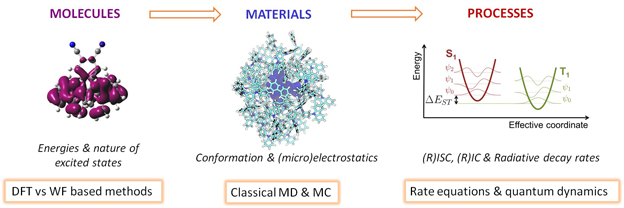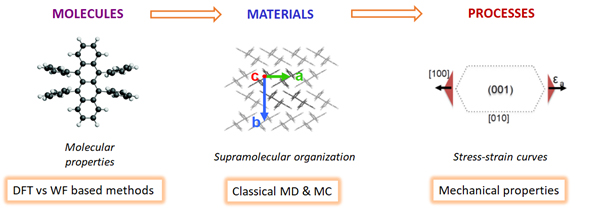Olivier Research Group
Multiscale modeling of the optoelectronic and mechanical properties of p-conjugated molecules and polymers
Organic p-conjugated materials are semiconducting materials. This property allows them to conduct electrons, absorb and emit light. These properties contributed to the development of another electronics, the organic electronics whose main applications are Organic Light-Emitting Diodes (OLEDs), Organic Solar Cells (OSCs) and Field-Effect Transistors (OFETs). These materials are also used in mechanically robust applications allowing to open the way towards an era of flexile electronics.

The properties of these materials are not solely described by the properties of the isolated molecules but largely depend on their properties in thin films. Practically speaking, the design of organic conjugated materials with improved properties requires an interdisciplinary approach involving the synthesis of molecules and polymers, the characterization of their properties in thin films and the preparation of devices. With the development of high-performance Computing centers, computational physics and chemistry became complementary tools to the experiments in materials sciences. The multiscale approaches allow to link the molecular and the mesoscopic scales through the combination of the following computational techniques:
- Quantum chemistry (DFT or ab initio) to characterize the electronic properties and the conformation of small molecules and conjugated polymers.
- Molecular dynamics to predict the supramolecular organization of the materials.
- Kinetic models based on rate equations, minimal electronic structure models to compute optoelectronic properties at the mesoscale and stress-strain simulations to obtain the mechanical properties.

Within the LPS, we apply these methodologies to topics associated with organic materials and developed an interest for the following research themes:
- Charge transport in conjugated polymers. The optimization of charge transport allows OFETs to carry out more operations per unit time. [1]
[1] “Short Contacts Between Chains Enhancing Luminescence Quantum Yields and Carrier Mobilities in Conjugated Copolymers”. T.H. Thomas, D.J. Harkin, A.J. Gillett, V. Lemaur, M. Nikolka, A. Sadhanala, J.M. Richter, J. Armitage, H. Chen, I. McCulloch, S.M. Menke, Y. Olivier, D. Beljonne, and H. Sirringhaus. Nature Communications 10 (2019) 2614.
- Study of the optical properties of light-emitting materials exhibiting Thermally Activated Delayed Fluorescence (TADF) or doublet emission. These materials are considered as the new generations of emitters for OLEDs. [2]

[2] “Computational Design of Thermally Activated Delayed Fluorescence Materials: The Challenges Ahead”. Y. Olivier, J.C. Sancho Garcia, L. Muccioli, G. D’Avino, and D. Beljonne. Journal of Physical Chemistry Letters 9 (2018) 6149-6163.
- Study of the mechanical properties of p-conjugated materials. Fundamental understanding of the relationship between the mechanical properties of the materials and their supramolecular organization. [3]

[3] “Unusual Electromechanical Response in Rubrene Single Crystals.” M. Matta, M.J. Pereira, S.M. Gali, D. Thuau, Y. Olivier, A. Briseno, I. Dufour, C. Ayela, G. Wantz, and L. Muccioli. Materials Horizons 5 (2018) 41-50.









